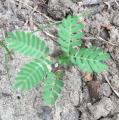
DMT-Nexus member
Posts: 1129 Joined: 12-Jul-2014 Last visit: 18-May-2024 Location: on the world in time
|
The other day, I was helping a friend build a roof over his travel trailer he bought to live in on the bit of land he has to live on. In the process I cut an oak branch with a reciprocating saw which was in the way of my ladder while I was working. The saw blade burned the bark a bit while I was cutting it. It smelled just like dmt if one one were smoke it. Someone once said that if it smelled like dmt it might be dmt and it might be some other tryptamine or whatever, so that’s why I named this post oaks and tryptamines. And while I haven’t had a chance to attempt an extraction I feel and think there’s something to it. I’m not quite sure which oak it is though. I could be live oak and it could overcup oak. My friend’s place is on a barrier island and live oaks may be smaller there due to wind . Oak is intriguing to me none the less.
|
|
|
|
|

DMT-Nexus member
Posts: 390 Joined: 24-Nov-2018 Last visit: 03-Mar-2024
|
I've been told that the "indole smell" exists everywhere in nature and isn't necessarily a marker
|
|
|

DMT-Nexus member
Posts: 1903 Joined: 15-Mar-2014 Last visit: 13-Dec-2025
|
Oak trees are rich in tannoids, which could be the smell you're describing. 'What's going to happen?' 'Something wonderful.'
Skip the manual, now, where's the master switch?
We are interstellar stardust, the re-dox co-factors of existence. Serve the sacred laws of the universe before your time comes to an end. Oh yes, you shall be rewarded.
|
|
|

DMT-Nexus member
Posts: 1129 Joined: 12-Jul-2014 Last visit: 18-May-2024 Location: on the world in time
|
Perhaps. But did anyone do a thorough analysis of North American trees for the presence of psychedelics? K Trout tested bean pod plants a lot perhaps but no one has really looked deep into it maybe. I’ve experimented with oaks a bit, haven’t done an acid to base extraction just yet though, yet the tea I’ve created seemed to tell me that there’s something to it. Tbh I intend to at least attempt an extraction of oak and or oaks of several kinds. Which leads me to another thought. I think there’s compounds out there in plants which are something like dmt yet novel.
|
|
|

DMT-Nexus member
Posts: 309 Joined: 15-Oct-2011 Last visit: 30-Jun-2021
|
Hey man how are ya? ....I have personally noticed that if I had used spice, I tend to smell that in a ton of stuff, Coffee, for instance and several other things that I cant think of at the time. SO that's usually if I had used up to several weeks earlier. Everything is worth trying, so try an A/B for funz , see what you get. but do smoke it heh REALITY 5.0
|
|
|

DMT-Nexus member
Posts: 1045 Joined: 12-Mar-2010 Last visit: 11-Jun-2024 Location: Urf
|
BundleflowerPower wrote:Perhaps. But did anyone do a thorough analysis of North American trees for the presence of psychedelics? K Trout tested bean pod plants a lot perhaps but no one has really looked deep into it maybe. I’ve experimented with oaks a bit, haven’t done an acid to base extraction just yet though, yet the tea I’ve created seemed to tell me that there’s something to it. Tbh I intend to at least attempt an extraction of oak and or oaks of several kinds. Which leads me to another thought. I think there’s compounds out there in plants which are something like dmt yet novel. I'm with BfP. There is SO much undiscovered plant chemistry out there. Including, especially, trees. Trees are awesome. I once chewed on an oak leaf and proceeded to feel great. YMMV.  ...There's only one way to find out! We are living in the Garden of Eden. From the unspoken
Grows the once broken
|
|
|

DMT-Nexus member
Posts: 1129 Joined: 12-Jul-2014 Last visit: 18-May-2024 Location: on the world in time
|
DreadedShaman wrote:I've been told that the "indole smell" exists everywhere in nature and isn't necessarily a marker I've heard that as well. Yet the smell I mentioned is the same smell as if one were to burn Chaliponga leaves, or Acacia Confuse root bark. I've been experimenting with burning various plant materials, and I've found that only some trees have that unmistakable smell. Including all the oaks I've which I've burned the material of (Including the leaves of live oak). Just thought I'd update this thread and mention that I still feel like oaks are a promising avenue of discovery.
|
|
|

DMT-Nexus member
Posts: 1129 Joined: 12-Jul-2014 Last visit: 18-May-2024 Location: on the world in time
|
BTW, Water Tupelo is another tree that I feel is worth a look.
|
|
|

Faustian Phytochem Investigator
 
Posts: 194 Joined: 31-Oct-2011 Last visit: 29-Nov-2025 Location: Oaxaca
|
Honey locust (Gleditsia triacanthos) has been listed in the literature as having tryptamines. Some Malple trees have Serotonin in the red leaves in the fall. I personally think the tryptamines are everywhere in nature. IE: a very old chemical system that nature uses for may reasons.
-D.
|
|
|

Boundary condition

Posts: 8617 Joined: 30-Aug-2008 Last visit: 24-Dec-2025 Location: square root of minus one
|
If anyone has any papers with acorn analyses I'd love to know. I'm currently working through a fair sized pile of acorns for food purposes and will be analysing the residual solution after tannin removal. “There is a way of manipulating matter and energy so as to produce what modern scientists call 'a field of force'. The field acts on the observer and puts him in a privileged position vis-à-vis the universe. From this position he has access to the realities which are ordinarily hidden from us by time and space, matter and energy. This is what we call the Great Work." ― Jacques Bergier, quoting Fulcanelli
|
|
|

Faustian Phytochem Investigator
 
Posts: 194 Joined: 31-Oct-2011 Last visit: 29-Nov-2025 Location: Oaxaca
|
Something like this?: Quote:...The main fatty acid in both fruit species was oleic acid (about 65%), followed by linoleic acid (about 16.5–17%) and palmitic acid (about 12.1–13.4%). The main triglyceride found in acorn oils was the OOO (oleic, oleic, oleic) triglyceride (33–38%), followed by the POO (palmitic, oleic, oleic) triglyceride (12.6–18.2%). In terms of sterols, the main component in acorn oils of both species was β-sitosterol (83.5–89%), followed by stigmasterol (about 3%). However, in Quercus suber L., acorn oil was found to consist to 10.2% of campesterol... "Characterisation of acorn oils extracted by hexane and by supercritical carbon dioxide" Looks like most things are on nutritional components via a quick search. -D.
|
|
|

Faustian Phytochem Investigator
 
Posts: 194 Joined: 31-Oct-2011 Last visit: 29-Nov-2025 Location: Oaxaca
|
One more to maybe look at (attached): "Extraction and Identification of phytochemicals in Iranian oak (Quercus brantii var. Persica) Collected in Arghavan Valley, Ilam County by HS- SPME and GC-MS"
|
|
|
DMT-Nexus member
Posts: 34 Joined: 03-Jan-2022 Last visit: 22-Jun-2023
|
I don't think that its practical and it's lightly off the topic but with sniff training; I wonder if you could train a dog to sniff out DMT containing plants? I have a book ("An immense world" by Ed Yong; the book details the diversity of sense in the animal kingdom and how various animals see, smell, hear, taste, and feel the world and how it services their evolutionary needs) and the first chapter starts out with dogs sense of smell. In general sniff training as opposed to heel/obedience training is much much much more enriching to our wagging, furry buddies so even if you aren't training them for being honorary DMTNexians the sniff training is super beneficial to them anyway. Most of us know how well dogs can smell; low blood sugar, oil pipeline leaks, cancer, sea turtle eggs, and even drugs like DMT are examples of things that dogs can be trained to sniff out. I mean, I think YOU yourself would have to perform the sniff training and most people aren't able to perform that task. Sorry for the derail. If anyone could sniff out tryptamine trees it wouldn't be us humans.
|
|
|

DMT-Nexus member

Posts: 856 Joined: 15-Nov-2009 Last visit: 03-Feb-2025
|
Once I came across some random guy talking about the presence of DMT in plane tree fruits. I couldn't find any study hinting at it. Not impossible, but slim chance. The consciousness of plants is a constant source of information for medicine, alimentation, and art, and an example of the intelligence and creative imagination of nature. Much of my education I owe to the intelligence of these great teachers. Thus I consider myself to be the “representative” of plants, and for this reason I assert that if they cut down the trees and burn what’s left of the rainforests, it is the same as burning a whole library of books without ever having read them.
~ Pablo Amaringo
|
|
|

Boundary condition

Posts: 8617 Joined: 30-Aug-2008 Last visit: 24-Dec-2025 Location: square root of minus one
|
dithyramb wrote:Once I came across some random guy talking about the presence of DMT in plane tree fruits. I couldn't find any study hinting at it.
Not impossible, but slim chance. This may have been a massive misinterpretation of a paper that I have encountered before which mentioned the presence of gramine in maple (Acer saccharinum) and the occurrence of DMT in some other plant (not a tree). Thanks for all the input so far. “There is a way of manipulating matter and energy so as to produce what modern scientists call 'a field of force'. The field acts on the observer and puts him in a privileged position vis-à-vis the universe. From this position he has access to the realities which are ordinarily hidden from us by time and space, matter and energy. This is what we call the Great Work." ― Jacques Bergier, quoting Fulcanelli
|
|
|

Faustian Phytochem Investigator
 
Posts: 194 Joined: 31-Oct-2011 Last visit: 29-Nov-2025 Location: Oaxaca
|
downwardsfromzero wrote:This may have been a massive misinterpretation of a paper that I have encountered before which mentioned the presence of gramine in maple (Acer saccharinum) and the occurrence of DMT in some other plant (not a tree). From: Review Tryptamine and Related Compounds in Plants (Smith 1977)? Lists: Acer rubrum - gramine - fruits Acer saccharinum - gramine - leaves And LOTS of others I think this is a paper that alot of people have pulled info from over the years. There's also: Indole Alkaloids of Acer saccharinum (the Silver Maple), Dictyoloma incanescens, Piptadenia colubrina, and Mimosa hostilis (Pachter et. al. JOC 1959) Which is the reference in the above Review. -D.
|
|
|

Boundary condition

Posts: 8617 Joined: 30-Aug-2008 Last visit: 24-Dec-2025 Location: square root of minus one
|
Yeah, that's the one I was thinking of. I would have dragged it out of my filing system except somehow it's not where I thought it might be  “There is a way of manipulating matter and energy so as to produce what modern scientists call 'a field of force'. The field acts on the observer and puts him in a privileged position vis-à-vis the universe. From this position he has access to the realities which are ordinarily hidden from us by time and space, matter and energy. This is what we call the Great Work." ― Jacques Bergier, quoting Fulcanelli
|
|
|

Faustian Phytochem Investigator
 
Posts: 194 Joined: 31-Oct-2011 Last visit: 29-Nov-2025 Location: Oaxaca
|
I had been meaning to go thru it again. So, this was a good excuse! Was one of the first papers I found WAY back when.
-D.
|
|
|

DMT-Nexus member
Posts: 218 Joined: 14-Apr-2018 Last visit: 05-May-2024
|
Its funny - one day in the upcoming of an intense ayahuasca Vision, this Space where the mother of nature comes to you and you can ask her questions, there I asked: what would be the plants of europe of interest for ayahuasca seeking. The answer came and named a few species, primarily trees. There was oak, chestnut, holly, Juniperus oxycedus, beech. I was really motivated after the session to get into drinking bark and leaves of oak trees but this leaved quickly like so many unknown experiments. But interesting. The cade tree is surely the european equivalent of palo santo. I would look more for beta carbolines in the oak family (oak, chestnut, beech) than dmt. Holly isn't so far from ilex goyusa, and there is a lot of magic about this tree. I am sure you can find some kind of Coffeine alcaloid in it. Arthur Dee was one of the greatest alchemists of all time, not likely to his dad, I forgot his name, this small James Bond sorcerer working for the queen of a... Hail Arthur!
|
|
|

DMT-Nexus member

Posts: 3090 Joined: 09-Jul-2016 Last visit: 03-Feb-2024
|
Dozuki wrote:Something like this?: Quote:...The main fatty acid in both fruit species was oleic acid (about 65%), followed by linoleic acid (about 16.5–17%) and palmitic acid (about 12.1–13.4%). The main triglyceride found in acorn oils was the OOO (oleic, oleic, oleic) triglyceride (33–38%), followed by the POO (palmitic, oleic, oleic) triglyceride (12.6–18.2%). In terms of sterols, the main component in acorn oils of both species was β-sitosterol (83.5–89%), followed by stigmasterol (about 3%). However, in Quercus suber L., acorn oil was found to consist to 10.2% of campesterol... "Characterisation of acorn oils extracted by hexane and by supercritical carbon dioxide" Looks like most things are on nutritional components via a quick search. -D. Don't acorns contain small amounts of hydrogen cyanide as well?
|